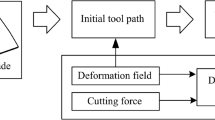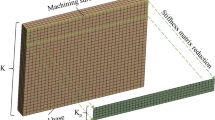Abstract
Difficult-to-machine material thin-walled parts with curved surface are widely used in industrial applications, and the shape accuracy is a basic requirement for ensuring the usability. Due to the low rigidity of the thin-walled curved surface parts, the cutting force becomes a sensitive factor for the machining deformation. In addition, high speed milling, that has an obvious attribute of small cutting force comparing with the traditional one, provides an effective way to process the thin-walled curved surface parts made by difficult-to-machine materials like titanium alloy. Moreover, the rigidity of the thin-walled curved surface parts is constantly changing along with the machining process, which leads to a more complex machining deformation when choosing different tool paths and affects the machining quality. To reduce the machining deformation, a proper cutting parameters combination which influences the machining deformation directly is obtained based on the established cutting force model, and then a deformation control strategy by planning tool path is put forward. At the same time, an efficient compensation method based on modifying cutter location point is proposed. Taking TC4 thin-walled arc-shaped parts as an example, experimental studies indicate that the largest deformation values reduce to 49 μm after compensation. Compared with the former 104 μm, the deformation degree decreases by 52.88 % when the thickness of the thin wall is 200 μm. The research provides an effective approach to reduce the machining deformation induced error for difficult-to-machine material thin-walled parts with curved surface.
Similar content being viewed by others
References
Jin Q, Liu SG (2007) Optimization of fixture scheme for milling thin-walled arc workpiece. Tool Eng 41(12):54–57
Abdolvand H, Sohrabi H, Faraji G, Yusof F (2015) A novel combined severe plastic deformation method for producing thin-walled ultrafine grained cylindrical tubes. Mater Lett 143:167–171
Wang ZG, Rahman M, Wong YS (2005) Tool wear characteristics of binderless CBN tools used in high-speed milling of titanium alloys. Wear 258(5–6):752–758
Liu WW, Zhang DH, Shi YY, Ren JX, Wang WH (2004) Study on net-shape NC machining technology of thin-blade of aero-engine. J Mech Sci Technol 23(3):329–331
Wang YQ, Mei ZY, Fan YQ (2004) Nonlinear finite element analysis of deformation in machining of thin-wall arc shaped workpiece. Aeronaut Manuf Technol 6:84–86
Alinia MM, Dastfan M (2006) Behaviour of thin steel plate shear walls regarding frame members. J Constr Steel Res 62(7):730–738
Andris L, Toms T (2015) The influence of high-speed milling strategies on 3D surface roughness parameters. Procedia Eng 100:1253–1261
Smith S, Dvorak D (1998) Tool path strategies for high speed milling aluminum workpiece with thin webs. Mechatronics 8(4):291–300
Iwabe H, Mizuochi M, Yokoyama K (1999) High accurate machining of thin wall shape workpiece by end mill. Proposal of twin spindle type machining and some experiments. Trans JSME A 65(632):1719–1724
Ratchev S, Liu S, Becker AA (2004) Milling error prediction and compensation in machining of low-rigidity parts. Int J Mach Tool Manuf 44(15):1629–1641
Chen WF, Xue JB, Tang DB, Chen H, Qu SP (2009) Deformation prediction and error compensation in multilayer milling processes for thin-walled parts. Int J Mach Tool Manuf 49(11):859–864
Nedelcu M, Cucu HL (2014) Buckling modes identification from FEA of thin-walled members using only GBT cross-sectional deformation modes. Thin Wall Struct 81(SI):150–158
Vetyukov YM (2010) Theory of thin-walled rods of open profile as a result of asymptotic splitting in the problem of deformation of a noncircular cylindrical shell. J Elast 98(2):141–158
Izamshah R, Mo JPT, Ding S (2012) Hybrid deflection prediction on machining thin-wall monolithic aerospace components. Proc Inst Mech Eng B J Eng 226(B4):592–605
Papastathis TN, Ratchev SM, Popov AA (2012) Dynamics model of active fixturing systems for thin-walled parts under moving loads. Int J Adv Manuf Technol 62(9–12):1233–1247
Liu G (2009) Study on deformation of titanium thin-walled part in milling process. J Mater Process Technol 209(6):2788–2793
Arnaud L, Gonzalo O, Seguy S, Jauregi H, Peigné G (2011) Simulation of low rigidity part machining applied to thin-walled structures. Int J Adv Manuf Technol 54(5–8):479–488
Tang ZT, Yu T, Xu LQ, Liu ZQ (2013) Machining deformation prediction for frame components considering multifactor coupling effects. Int J Adv Manuf Technol 68(1–4):187–196
Wojciechowski S (2015) The estimation of cutting forces and specific force coefficients during finishing ball end milling of inclined surfaces. Int J Mach Tool Manuf 89:110–123
Han HZ, Li BX, Wu H, Shao W (2015) Multi-objective shape optimization of double pipe heat exchanger with inner corrugated tube using RSM method. Int J Therm Sci 90:173–186
He W, Xue WD, Tang B (2012) Optimization design of experiment method and data analysis. China Chemical Industry Press, Beijing
Author information
Authors and Affiliations
Corresponding author
Rights and permissions
About this article
Cite this article
Gao, Yy., Ma, Jw., Jia, Zy. et al. Tool path planning and machining deformation compensation in high-speed milling for difficult-to-machine material thin-walled parts with curved surface. Int J Adv Manuf Technol 84, 1757–1767 (2016). https://doi.org/10.1007/s00170-015-7825-4
Received:
Accepted:
Published:
Issue Date:
DOI: https://doi.org/10.1007/s00170-015-7825-4




